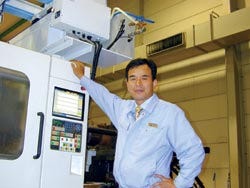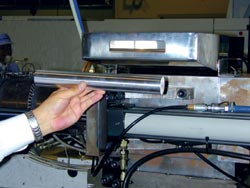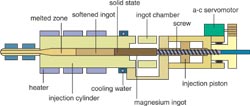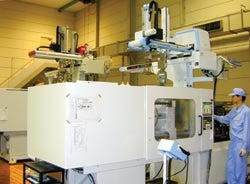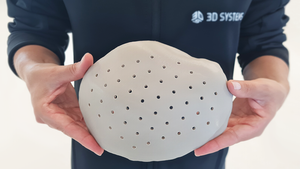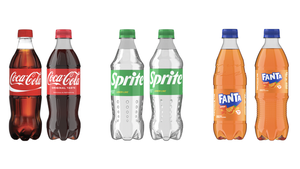October 24, 2002
|
Misao Fujikawa, president of Sodick Plustech, believes he has dreamed up a more profitable way to mold Mg parts with his new Mg-Plus molding system. It is designed to improve good parts yield while being safe, energy efficient, and easy to use. |
At any given time Misao Fujikawa, the visionary president of Sodick Plustech Co. Ltd. (Kaga-City, Ishikawa, Japan), will take a nap. Whether or not he’s actually asleep or in deep meditation, the dreams he catches are usually good ones. Take the Mg-Plus, for instance.
Picture, if you will, a plunger injection molding machine in which the material itself is the plunger. That’s the Mg-Plus. A solid magnesium rod is inserted into the barrel of its hybrid injection unit. As shown in the illustration below, a servodriven screw literally screws itself into the back of the Mg bar stock. An accumulator-assisted, hydraulically powered ram then pushes the Mg “plunger.†Maximum injection speed is about 2500 mm/sec.
The Mg rod is not only the machine’s plunger, it’s also its check ring. Barrel heating is profiled to keep the Mg rod molten up front (585 to 660C), soft in the middle, and solid cold in the rear. Standard ceramic heater bands are used. The diameter of the front end of the rod expands under heat and seals the system, eliminating backflow. Accurate shot size control is the reported result. And air is prevented from entering into the self-sealed cylinder.
|
|
Above, Mg ingots, said to be safer than Mg chips, are loaded into a hopper on the Mg-Plus and are then fed into the machine’s hybrid injection unit. In a process somewhat akin to ram extrusion, the front end of the bar stock is melted and metered into the mold (see diagram below). |
|
Each Mg rod is comprised of ingots, and up to three ingots can be in the barrel at a time. Sodick supplies its own proprietary brand of AZ-91 Mg ingots for use in its Mg-Plus. When the last Mg rod is injected, the piston automatically retracts, and a new rod falls into place for the next round of shots, like a round from an ammunition clip. In operation, the Mg-Plus is as quiet as a plastics molding machine. Sound simple? That’s the idea.
“Simple is always better for me. I have a simple brain,†says Fujikawa.
Safety and Cost
Sony Corp. asked Sodick Plustech to find a better way to make Mg parts. Fujikawa and company believe they have improved the Mg molding process itself, while also improving its operational safety aspects.
Mg bar stock is much safer than Mg chips. The total surface area of Mg chips is proportionally larger than a solid Mg billet, so chips are easier to oxidize and ignite, according to Fujikawa. Ingots reportedly are safer to ship, store, handle, and mold. Unlike hot chamber diecasting, the Mg-Plus uses no SF6 gas. And unlike chip molding processes, only a minimal amount of argon gas is used as a preparatory step.
The injection cylinder of the Mg-Plus can be cleaned at ambient temperatures, reducing maintenance downtime. Since it’s self-sealing, there reportedly is no sludge in the cylinder to clean out. Also, there are fewer moving parts in the injection unit, so there’s less wear and tear. Energy and downtime are saved through proportional heating of the ingots. It only takes about a half hour to warm up the barrel and start molding.
The shot volume consistency provided by the injection system design reportedly improves good parts yield. Many secondary finishing processes presently used in Mg parts manufacturing will be eliminated, according to company sources. Mg-Plus machines also are generally less expensive than other Mg injection molding systems on the market. (See “A New Magnesium Molding Process,†August 2002 IMM for an initial report.)
Stamping Out Secondaries
The clamp end of Sodick Plustech’s Mg-Plus is the same one found on its EH series of plastics and PIM presses. EH machines are designed for precision repeatability, thin-walling, and tight-tolerance molding of complex parts. PP speaker cones that are .1 mm thick have been molded on EH machines. Their clamp mechanism is a hybrid design with direct, servodriven clamp opening and closing via a ballscrew, and hydraulically powered clamping. All machines share the company’s 2000 Series control system.
|
Presently available in 785- and 2550-kN sizes, Sodick Plustech may exhibit its Mg-Plus machine next year at NPE. It’s on show this month at IPF ’02 in Tokyo. A 260-metric-ton model, such as this test unit, sells for less than $490,000. |
Sodick has long-standing alliances with auxiliaries suppliers in Japan and can provide complete manufacturing cells. It also has a well-rounded tooling background; after all, it built the world’s first CNC EDM machine.
Yoichi Seki, chairman of publicly held Sodick Plustech, is brimming over with confidence that the Mg-Plus will be a success. Orders were pouring in before the first machine was completed in July.
Seki’s sure that the lower manufacturing costs and process control simplicity of the Mg-Plus will win over those already involved in Mg molding. He’s equally confident that its improved productivity will force many away from plastics into lighter, stronger, recyclable Mg, which, he says, is a better material for many applications.
“Zero deburring, trimming, tumbling, painting . . . just molding and plating or coating. That’s our final destination. And zero lubrication. That was another Sony requirement. We are now developing a mold based on diamond-like carbon that will require no lubrication,†Seki said enthusiastically, turning to Fujikawa for his corroboration.
Fujikawa was asleep.
Contact information |
You May Also Like
